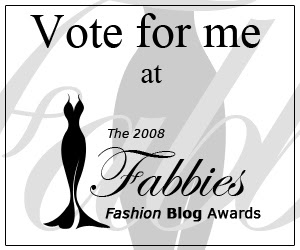New York Fashion Week, Fall '08 is in full gear and it is clear the theme of "change" in the Presidential elections is spilling over on the runways. "Change" is in the air as Fall ’08 departs from the very traditional to reveal a cheerful modern twist on timeless classics. Below is our take for the first two days of NY Fashion Week Fall ’08. Enjoy. Color: Fall '08 palettes include staples such as grays and blacks. However, designers are also embracing change with invigorating rich color palettes such as yellows, purples, camels, baby blue, emerald greens, chocolates, oranges and warm reds.


 Erin Fetherston,Nicole Miller, Erin Fetherson
Erin Fetherston,Nicole Miller, Erin Fetherson


 Elie Tahari
Elie Tahari


 Left to Right: BCBG Max Azria, Rachel Roy & Douglas Hannat
Left to Right: BCBG Max Azria, Rachel Roy & Douglas Hannat


 Kimora Lee Simmons-KLS
Kimora Lee Simmons-KLS
Read More
Fabrics: Wools and Jerseys remain dominant to keep us fashionably warm. But, watch for models sashaying down the runway draped in luxurious silks which sort of makes you think it's spring all over again. Trends: Designers are keeping things very simple but reaching back in time to give us bits and pieces of the 20s, 30s and a tad bit of the '40s. Take for example, Kimora Lee Simmons who gave us a very modern take on the flapper looks of the 20s complete with a refined bob hair do, brandishing of cigarette holders, poise and a whole lot of attitude! Enjoy our picks below! All photos by Marcio Madiera with the exception of KLS by Imax Tree. Jason Wu, Yigal Azrouel, Jason Wu


 Erin Fetherston,Nicole Miller, Erin Fetherson
Erin Fetherston,Nicole Miller, Erin Fetherson

 Elie Tahari
Elie Tahari

 Left to Right: BCBG Max Azria, Rachel Roy & Douglas Hannat
Left to Right: BCBG Max Azria, Rachel Roy & Douglas Hannat

 Kimora Lee Simmons-KLS
Kimora Lee Simmons-KLS




 Creating a clearly defined pathway for African Fashions in the West is not one Ladybrille intends to embark on with only Africans. Accordingly, we reach out to our beautiful Black brothers and sisters as we, throughout this month, celebrate the many accomplishments and contributions of Blacks to the fashion industry nationally and internationally. We also extend our hands of friendship to the beautiful non-African/Black fashion-forward women whose challenges and successes parallel ours. Be sure to watch out for our upcoming feature with the very passionate and energetic San Franciscan Irene Hernandez-Feiks; a Latina who through her event "Chillin'" has created opportunities for emerging artists, designers & filmmakers within San Francisco and across the country. Similarly, be on the look out for the Ladybrille Woman of the Month Kaushie Adieseshan, a USA based emerging Indian designer who is gaining momentum in India and at IMG's Indian Lakme Fashion Week.
Creating a clearly defined pathway for African Fashions in the West is not one Ladybrille intends to embark on with only Africans. Accordingly, we reach out to our beautiful Black brothers and sisters as we, throughout this month, celebrate the many accomplishments and contributions of Blacks to the fashion industry nationally and internationally. We also extend our hands of friendship to the beautiful non-African/Black fashion-forward women whose challenges and successes parallel ours. Be sure to watch out for our upcoming feature with the very passionate and energetic San Franciscan Irene Hernandez-Feiks; a Latina who through her event "Chillin'" has created opportunities for emerging artists, designers & filmmakers within San Francisco and across the country. Similarly, be on the look out for the Ladybrille Woman of the Month Kaushie Adieseshan, a USA based emerging Indian designer who is gaining momentum in India and at IMG's Indian Lakme Fashion Week.

